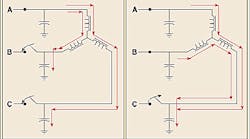Are your lights flickering? Does it sound like someone's banging on the inside of your transformer with a monkey wrench? You might be experiencing ferroresonance. Editorial Director John DeDad examines this phenomenon caused by isolated transformers.
Q. We've experienced lighting flicker in our plant at various times and reported this condition to our utility. After checking our site and the service entrance, they cited the single-phase recloser on a pole line that feeds one of the utility's transformers as the culprit. The utility said the problem recloser was causing ferroresonance. Can you explain ferroresonance so that we can better understand what happened?
DeDad's answer: The book “Electrical Power Systems Quality” (ISBN 0-07-138622-X) is an excellent source of information on this. Basically, ferroresonance is a kind of resonance that usually involves capacitance and iron-core inductance. Theoretically, it causes disturbances when the magnetizing impedance of a transformer is placed in series with a system capacitor, which is usually when there's an open phase conductor. In the real world, it usually occurs when unloaded transformers become isolated on underground cables of certain lengths. (Overhead utility distribution lines aren't a factor because their capacitance isn't great enough to yield the conditions needed to create ferroresonance.)
The magnetizing reactance of a 35kV distribution transformer is several times higher than that of a similarly sized 15kV unit. So ferroresonance is somewhat more common at higher voltages.
You didn't provide any specific information on your distribution system and referenced transformer, so I can only guess as to what happened at your site. You probably have a grounded wye transformer (the most commonly used in underground distribution systems because it is more resistant to ferroresonance). Typically, any one of the following situations or activities may cause ferroresonance:
-
Manual switching of an unloaded, cable-fed, 3-phase transformer, where only one phase is closed (above left).
-
Same as above, except where only one phase is open (above right).
-
One or two riser-pole fuses blowing, leaving the fed transformer with one or two phases open.
I emphasize the word “may” because the above events don't always lead to ferroresonance. However, there are certain system conditions that can increase the likelihood of ferroresonance:
-
Higher utility distribution voltage levels, most notably 25kV and 35kV systems
-
Switching of lightly loaded or unloaded transformers
-
Ungrounded transformer primary connections
-
Very long underground cable feeders
-
Cable damage and manual switching during construction of underground cable systems
-
Distribution systems with low short-circuit currents
-
The use of low-loss transformers
-
The use of single-phase switching devices on 3-phase systems
One of the common indicators of ferroresonance is the situation you cited. The condition causes the magnitude of the voltage to fluctuate — wildly in some instances — and you'll actually see lights flicker. Another indicator is a loud banging from within the transformer enclosure. And another visual indicator is charring or bubbling of paint on the top of the transformer tank, which indicates transformer overheating, especially when the transformer's iron core is driven into saturation.
Finally, another thing to look for is surge arrester failure from overvoltages that usually accompany ferroresonance. These devices are designed to intercept brief overvoltages and clamp them to acceptable levels. Although they may be able to withstand several overvoltage events, they do have a definite limit to their energy absorption capabilities.
Got PQ problems? Send your questions to [email protected].




